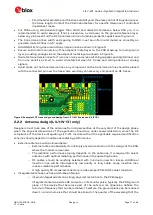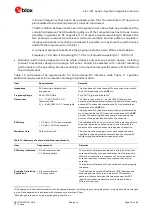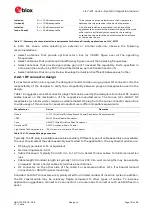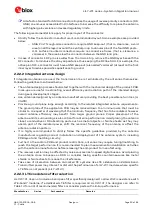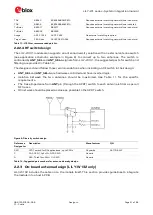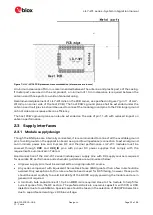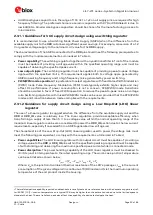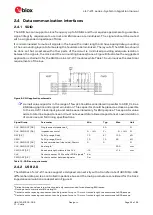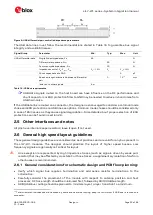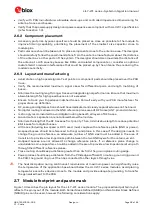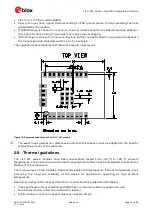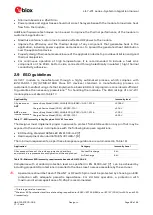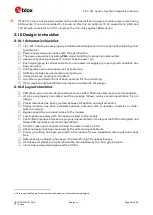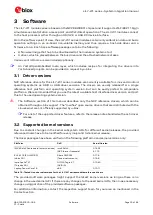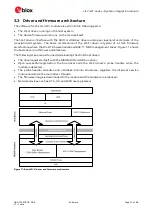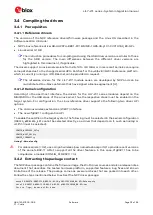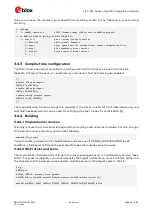
LILY-W1 series - System integration manual
UBX-15027600 - R09
Design-in
Page 18 of 64
C1 - Public
minimum frequency that has to be radiated, given that the orientation of the ground
plane related to the antenna element must be considered.
The RF isolation between antennas in the system has to be as high as possible and the
correlation between the 3D radiation patterns of the two antennas has to be as low as
possible. In general, an RF separation
of at least a quarter wavelength between the
two antennas is required to achieve a minimum isolation and low pattern correlation;
increased separation should be considered if possible, to maximize the performance
and fulfil the requirements in Table 11.
A numerical example to estimate the physical restriction on a PCB is shown below:
Frequency = 2.4 GHz
Wavelength = 12.5 cm
Quarter wavelength = 3.125 cm
•
Radiation performance depends on the whole product and antenna system design, including
product mechanical design and usage. Antennas should be selected with optimal radiating
performance in the operating bands according to the mechanical specifications of the PCB and
the whole product.
Table 10 summarizes the requirements for the antenna RF interface while Table 11 specifies
additional requirements for dual antenna design implementation.
Item
Requirements
Remarks
Impedance
50
Ω
nominal characteristic
impedance
The impedance of the antenna RF connection must match
the 50
Ω
impedance of the
ANT
pin.
Frequency Range
2400 - 2500 MHz
For 802.11b/g/n and Bluetooth
®
.
Return Loss
S
11
< -10 dB (VSWR < 2:1)
recommended
S
11
< -6 dB (VSWR < 3:1) acceptable
The Return loss or the S
11
, as the VSWR, refers to the
amount of reflected power, measuring how well the primary
antenna RF connection matches the 50
Ω
characteristic
impedance of the
ANT
pin.
The impedance of the antenna termination must match as
much as possible the 50
Ω
nominal impedance of the
ANT
pin over the operating frequency range, maximizing the
amount of the power transferred to the antenna.
Efficiency
> -1.5 dB ( > 70% ) recommended
> -3.0 dB ( > 50% ) acceptable
The radiation efficiency is the ratio of the radiated power to
the power delivered to antenna input: the efficiency is a
measure of how well an antenna receives or transmits.
Maximum Gain
Refer to Section 5
The maximum antenna gain must not exceed the value
specified in type approval documentation to comply with
regulatory agencies radiation exposure limits.
Table 10: Summary of antenna interface requirements
Item
Requirements
Remarks
Efficiency imbalance
< 0.5 dB recommended
< 1.0 dB acceptable
The radiation efficiency imbalance is the ratio of the first
antenna efficiency to the second antenna efficiency: the
efficiency imbalance is a measure of how much better an
antenna receives or transmits compared to the other
antenna.
The radiation efficiency of the antennas should be roughly
the same.
Envelope Correlation
Coefficient
< 0.4 recommended
< 0.5 acceptable
The Envelope Correlation Coefficient (ECC) between one
antenna and the other is an indicator of 3D radiation
pattern similarity between the two antennas: low ECC
results from antenna patterns with radiation lobes in
different directions.
3
RF separation is the total dimension of the antenna element, including its grounding elements. It is at least half wavelength
in size. Good separation is achieved with distances greater than 20 cm.
4
Wavelength referred to a signal propagating over the air.














